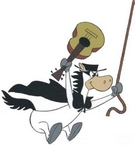Sardaukar
Posts: 9847
Joined: 11/28/2001
From: Finland/Israel
Status: offline

|
quote:
ORIGINAL: wild_Willie2
How many times would the JU-88 actually have been used in the dive bomber role?, I know that it had dive breaks, but could such an massive ac really have dived at 80+ degrees like his smaller counterparts ??
It was used regularly as dive bomber in Finnish Air Force (and of course by Germans) in WW II. Dive angles were 60-80 degrees. In long run it was discovered that extensive diving combat ops strained the structure, so dive breaks in FAF Ju-88s were removed and dive angle was made shallower (45 degrees). It was still dive-bombing, though, Stuvi dive-bombing sight was used. And diving speeds were even increased due to removal of dive breaks.
Just more trivia from other forum:
"But of course, tactics used depended on target. With an area target the 88s used level bombing tactics. For more specific targets, glide bombing. Dive bombing was used inititally, even in 90 degree dives, but that was abandoned to save the planes from the stress, as Finns had very limited capability to repair planes. Glide bombing was found to be very accurate, with best pilots being able to hit the targets within 10 meter accuracy. Glide bombing was also found to be the safest method, since the AA fire had much harder time tracking a bomber coming down on 700-800 km glide, than a bomber fying level or diving with 70-90 degree angles."
Note that Finnish use of term "glide bombing" differs from US use. Glide bombing in FAF ment 45 degree attack using Stuvi dive bombing sight.
"Let me quote you "Lentäjän Näkökulma IV" which is a book about technical and operational aspects of Finnish bombers in WW2:
"After initial operational phase, Finns began to use 45 degree diving angle instead of normal 60 to 80 degrees. As dive brakes were removed, increased diving speed (up to 700km/h) [435mph] made it more difficult for enemy AAA to track the plane. ... To minimize losses, bomb release altitude was often set to 2500 metres [8000ft]. Pull-up would usually take 500 metres. Due to higher release altitude, accuracy was not as good as it had been with smaller dive bombers [Ju-87, Fokker CX presumably]. However in good conditions, experienced crews could hit within ten metres of target."
I've read memoirs of Flt.Mst Rantala, who was Ju-88 pilot during the war, and glide bombing (which is of course nothing but shallow angle dive bombing) was used plenty. I've also read numerous accounts by fighter pilots escorting Ju-88's, who testimony that Ju's dive bombed often."
"To add here. Let's see how PLeLv 44 operated during summer battles 1944 ... (FInnish JU-88 squadron, for others).
12.6. level bombing at night, 2345-0015
14.6. dive bombing with 12 88s, target Soviet tank unit
16.6. dive bombing with 10 88s, target Soviet ships
19.6. dive bombing, target Soviet ships
22.6. dive bombing, target area target
23.6. both dive and level bombing, 11 88s, target Soviet shipping and invasion beachhead. Cloud level low 2600-3000 meters, so some planes were forced to bomb from level. (diving preferred)
28.6. diving bombing with 11 ju88s, target Tali bridges
29.6. dive bombing with 12 88s, target Soviet troop concentration
30.6. dive bombing with 12 88s, target troop concentration. Dive from 4000 meters, bomb release at 2500 meters.
1.7. dive bombing with 7 88s, target Soviet shipping
"Quote: Bombed with dive bombing 6-7 large ships, east of Pulliniemi at 14.35. Bombs 5 x 1000 kg, 4 x 500 kg and 14 x 250 kg. One direct hit to a large ship, ship exploded. Another big ship hit with two bombs. A third smaller ship sunk immediately. 1000 kg bomb missed a large ship with 15 meters, the ship did not move anymore and leaked oil. JK-262 was attacked with two Soviet fighters, who followed it for 30-40 km without firing. Own Messerschmitts escorted"
-
3.7. attack, no mention of tactics
5.7. both level and dive bombing, 10 Ju88s, target Soviet forces at Tali-Ihantala
5.7. attack to Äyräpää, no mention of tactics
8.7. dive bombin with 9 88s, target Soviet tanks, concentrations and artillery at Äyräpää.
Source: Suomen Ilmavoimien Historia 4, LeR4 (Finnish Air Force History, Bomber Regiment 4), published 2002.
http://www.kolumbus.fi/kari.stenman/sih19.html
and History of PommitusLentoLaivue 44 by Matti Hämäläinen, 2003"
Hope this clears the dive-bombing aspect...
< Message edited by Sardaukar -- 2/23/2006 2:58:31 PM >
|
 Printable Version
Printable Version











 as for the range max range of He-111 was 1960 km... for H-16 version an and Ju-88A range was 2730 km... just swith them into miles and you have it:) BTW Ju-88 was used as Dive bomber , Level Bomber and Night Fighter... this plane was nible as for its size...
as for the range max range of He-111 was 1960 km... for H-16 version an and Ju-88A range was 2730 km... just swith them into miles and you have it:) BTW Ju-88 was used as Dive bomber , Level Bomber and Night Fighter... this plane was nible as for its size...













 . At least a nuisance in 1943... (nothing that the Germans did in 1944 was eventually strategically significant because they had already lost the war by then!).
. At least a nuisance in 1943... (nothing that the Germans did in 1944 was eventually strategically significant because they had already lost the war by then!). 





 New Messages
New Messages No New Messages
No New Messages Hot Topic w/ New Messages
Hot Topic w/ New Messages Hot Topic w/o New Messages
Hot Topic w/o New Messages Locked w/ New Messages
Locked w/ New Messages Locked w/o New Messages
Locked w/o New Messages Post New Thread
Post New Thread